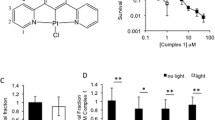Abstract
Photoinduced cytotoxicity mediated by a triphenylenamine-modified platinum diimine complex in human breast adenocarcinoma cells has been studied by cell viability assay. The triphenylenamine-modified platinum diimine complex showed more potent cytotoxicity in light than its carboxylate-modified analogue. To gain insights into the mechanism of photodynamic activity of this class of platinum diimine complexes, flow cytometric analyses were performed. The results suggest that upon irradiation the two platinum diimine complexes studied could induce cell cycle arrest in G2/M or S phase, and both of them could induce cancer cell death by apoptosis.




Similar content being viewed by others
References
Bachler V, Olbrich G, Neese F, Wieghardt K (2002) Theoretical evidence for the singlet diradical character of square planar nickel complexes containing two o-semiquinonato type ligands. Inorg Chem 41:4179–4193
Banerjee S, Chakravarty AR (2015) Metal complexes of curcumin for cellular imaging, targeting, and photoinduced anticancer activity. Acc Chem Res 48:2075–2083
Bonnett R (1995) Photosensitizers of the porphyrin and phthalocyanine series for photodynamic therapy. Chem Soc Rev 24:19–33
DiPaola RS (2002) To arrest or not to G2-M cell-cycle arrest. Clin Cancer Res 8:3311–3314
Fukui H, Kishi R, Minami T, Nagai H, Takahashi H, Kubo T, Kamada K, Ohta K, Champagne B, Botek E (2008) Theoretical study on second hyperpolarizabilities of singlet diradical square planar nickel complexes involving o-semiquinonato type ligands. J Phys Chem A 112:8423–8429
Garg AD, Nowis D, Golab J, Agostinis P (2010) Photodynamic therapy: illuminating the road from cell death towards anti-tumour immunity. Apoptosis 15:1050–1071
Herebian D, Bothe E, Neese F, Weyhermueller T, Wieghardt K (2003) Molecular and electronic structures of bis-(o-diiminobenzosemiquinonato)metal(II) complexes (Ni, Pd, Pt), their monocations and -anions, and of dimeric dications containing weak metal-metal bonds. J Am Chem Soc 125:9116–9128
Juzeniene A, Peng Q, Moan J (2007) Milestones in the development of photodynamic therapy and fluorescence diagnosis. Photochem Photobiol Sci 6:1234–1245
Knoll JD, Turro C (2015) Control and utilization of ruthenium and rhodium metal complex excited states for photoactivated cancer therapy. Coord Chem Rev 282–283:110–126
Konno Y, Matsushita N (2006) pH-dependent color-change behavior of bis(o-phenylenediamine)platinum(II) complex and pH-dependent Redox of bis(o-semibenzoquinonediimine)platinum(II) complex. Bull Chem Soc Jpn 79:1046–1053
Lucky SS, Soo KC, Zhang Y (2015) Nanoparticles in photodynamic therapy. Chem Rev 115:1990–2042
Maggioni D, Galli M, D’Alfonso L, Inverso D, Dozzi MV, Sironi L, Iannacone M, Collini M, Ferruti P, Ranucci E, D’Alfonso G (2015) A luminescent poly(amidoamine)–iridium complex as a new singlet-oxygen sensitizer for photodynamic therapy. Inorg Chem 54:544–553
Masuya A, Iki N, Kabuto C, Ohba Y, Yamauchi S, Hoshino H (2010) pH-responsive switching of the near-infrared absorption of the water-soluble bis(o-diiminobenzosemiquinonato)platinum(II) complex. Eur J Inorg Chem 22:3458–3465
Mosmann T (1983) Rapid colorimetric assay for cellular growth and survival: application to proliferation and cytotoxicity assays. J Immunol Methods 65:55–63
Noro S, Chang HC, Takenobu T, Murayama Y, Kanbara T, Aoyama T, Sassa T, Wada T, Tanaka D, Kitagawa S, Iwasa Y, Akutagawa T, Nakamura T (2005) Metal-organic thin-film transistor (MOTFT) based on bis(o-diiminobenzosemiquinonate) nickel(II) complex. J Am Chem Soc 127:10012–10013
Ochsner M (1996) Light scattering of human skin: a comparison between zinc(II)- phthalocyanine and photofrin II®. J Photochem Photobiol, B 32:3–9
Vogler A, Kunkley H (1980) Photooxidation of the ligands of bis(o-semiquinonediimine)nickel(II) and -platinum(II). Angew Chem Int Ed Engl 19:221–222
Wu Q, Fan C, Chen T, Liu C, Mei W, Chen S, Wang B, Chen Y, Zheng W (2013) Microwave-assisted synthesis of arene ruthenium(II) complexes that induce S-phase arrest in cancer cells by DNA damage-mediated p53 phosphorylation. Eur J of Med Chem 63:57–63
Wyllie AH (1980) Glucocorticoid-induced thymocyte apoptosis is associated with endogenous endonuclease activation. Nature 284:555–556
Zhang Z, Dong X (2009) Interaction of DNA with a novel photoactive platinum diimine complex. Biometals 22:283–288
Zhang Z, Dai R, Ma J, Wang S, Wei X, Wang H (2015a) Photoinduced DNA damage and cytotoxicity by a triphenylamine-modified platinum-diimine complex. J Inorg Biochem 143:64–68
Zhang Z, Li H, Dai R, Chai A (2015b) Photoinduced cytotoxicity by a platinum diimine complex employing magnetite–silica nanocomposites as delivery vehicles. Biometals 28:945–950
Acknowlegements
We thank the Natural Science Foundation of Shanxi Province for financial support (No. 2012011005-8).
Author information
Authors and Affiliations
Corresponding author
Rights and permissions
About this article
Cite this article
Zhang, Z., Dai, R. Photoactive platinum diimine complexes showing induced cancer cell death by apoptosis. Biometals 30, 37–42 (2017). https://doi.org/10.1007/s10534-016-9985-6
Received:
Accepted:
Published:
Issue Date:
DOI: https://doi.org/10.1007/s10534-016-9985-6




